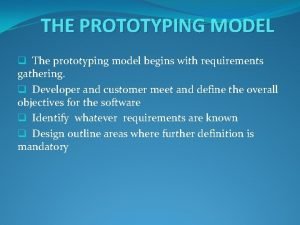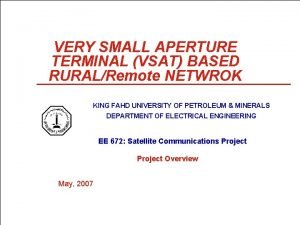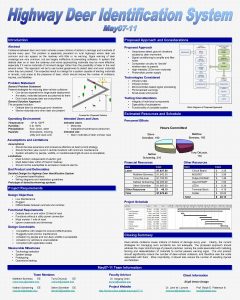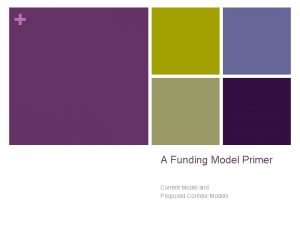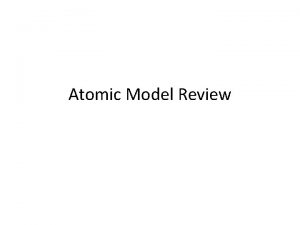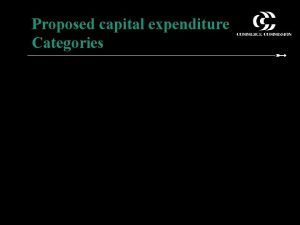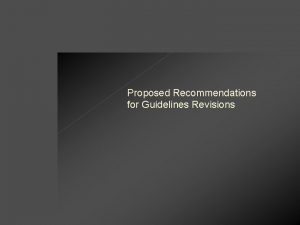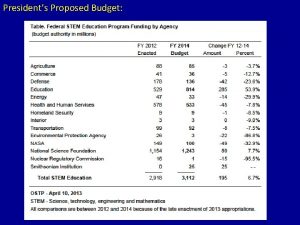PROPOSED MODEL FOR THE INTRODUCTION OF A RURALREMOTE






















- Slides: 22

PROPOSED MODEL FOR THE INTRODUCTION OF A RURAL/REMOTE ALLOWANCE PHSDSBC – 28 MARCH 2019 Slide 1

PURPOSE To request the PHSDSBC to- a) note the model, methodology and approach; b) support the criteria of identifying areas; c) support the identified areas; and d) support that the model be adopted. Slide 2

PURPOSE FOR INTRODUCING ALLOWANCE – For the circumstantial payment of a rural allowance to incentivize Social Services Professions in identified rural areas in terms of the demarcation principles to ensure equality within the sector. – To ensure equity and equality in the Public Service in general and between DSD and Health specifically; – Improvement in services through the retention of SSP’s in specifically demarcated areas that are classified as remote with higher levels of poverty. Slide 3

BACKGROUND • The Social Development Sector is struggling to attract and retain social workers in inhospitable areas. • A service provider (CSIR) was appointed to scientifically identify areas through a GIS study to ensure that incentives are paid appropriately. • During the first phase of the project qualitative research was conducted in the form of focus groups and during the second phase a remoteness/incentive index was developed.

BACKGROUND (continue) • The model for the payment of a rural/remote allowance was presented to the Social Development MINMEC during August 2010 which was consequently approved for implementation. • The DPSA was approached on three occasions to request that the Mandate Committee convene to approve sufficient funds in the Adjusted Estimates of Expenditure and over the MTEF to fund the implementation 5

EVIDENCE FOR AND EXTENT OF THE PROBLEM • Although the OSD for SSP & related Occupations made wide ranging provisions to attract and retain SSPs, the sector is still struggling in rural areas to attract and retain SSPs thereby compromising the provision of services to the poorest and most vulnerable sectors of society. • Researchers established a general reluctance by SSPs to work in rural areas due to poor infrastructure, housing, schools, shopping malls and services found in urban/semi urban areas. • This is evident in the vacancy rate in rural areas that ranges between 12 and 14% in certain provinces. • Higher recruitment cost due to repeated advertising of posts. • The turnover of SSPs results largely from movement between NGOs, government departments, private and corporate sector, as well as migration from rural to urban areas and to other countries. • gh 6

RATIONALE • Targeted intervention to incentivize SSPs to work in remote/rural areas. • Allowance seeks to provide partial relief for the inconvenience of being stationed in inhospitable areas. • Allowance aims to assist with amongst others transport / travel, schooling, housing and social amenities. • Payment of the allowance will ensure equality within the Health and Social Development Sector. 7

PRODUCING AN INDEX • • • Two factors (living and physical working conditions) were identified during qualitative consultations. The two factors were quantified through variables, namely: living conditions by incorporating the urban functional index which is the degree to which people in a specific area have access to a variety of urban functions and services, and working conditions by incorporating the condition of roads as well as profiling the population in terms of poverty. Living conditions>> indicated by >>Accessibility index Working conditions >>indicated by>> Work burden index Incentive index based on combination of Accessibility and work burden indexes, classified into 6 categories. 8

MODEL Working Conditions Living Conditions Work Load / Volume Proportion of Poverty Accessibility Index Incentive Index Work Burden Index Slide 9

INTERPRETING THE INDEX Index Definition Allow. 1 -2 Areas might contain small poverty pockets. Individuals can however live in excellent residential areas and commute to less favourable areas on a daily basis. Individuals can maximize quality of life by weighing up home and work environments. No 3 Area generally fall into sparsely populated ‘deep rural’ areas, which are relatively far from big towns and cities. Shares characteristics with categories 4 & 6, without the large proportion of poor. Yes 4 Similarly ‘deep rural’ but with much higher poverty ratios. Yes 5 Area is quite isolated with high concentration of poverty extending over a large area. Yes 6 Area is more isolated than category 5, with equally high concentration of poverty extending over a large area. Yes 10

FACTORS/VARIABLES TO DEFINE RURALNESS a) b) c) d) e) f) g) h) i) Distances travelled for work Lack of resources and facilities Lack of basic services Remoteness/inaccessibility Poor access to information Poverty and underdevelopment Livelihood options Settlement patterns Language and cultural factors 11

IDENTIFIED AREAS PER PROVINCE Index KZN FS EC NC WC MPU LIM NW GP Total 3 37 8 7 6 3 16 16 5 0 98 4 24 35 18 8 1 22 73 7 0 188 5 19 12 21 2 0 13 10 9 0 86 6 2 0 10 0 1 15 0 28 Total 82 55 56 16 4 51 100 36 0 400 SSPs stationed in Gauteng will not qualify for the payment of a rural allowance. 12

POST ESTABLISHMENT (INDEX 3 – 6) Total Funded Posts Filled Posts Funded Vacant posts Eastern Cape 3023 3000 23 Free State 651 554 97 0 0 0 Kwa. Zulu Natal 963 0 Limpopo 2307 2247 60 Mpumalanga 1687 1660 27 Northern Cape 507 439 68 North West 1268 1123 145 8 8 0 10414 9994 420 PROVINCE Gauteng Western Cape Total Analysis: The overall vacancy rate is 4% but if you do the calculation per province the vacancy rate is much more higher e. g. FS – 14. 9%, NC – 13. 4% and NW – 11. 4% 13

VACANCIES PER INDEX Index 3 Index 4 Index 5 Index 6 Province Filled Vacant EC 851 7 826 7 1323 9 0 0 FS 309 57 167 0 78 0 0 40 GT 0 0 0 0 KZN 423 0 456 0 84 0 0 0 LIM 1846 48 341 12 60 0 MPU 470 1 1190 26 0 0 NC 15 12 340 55 84 1 0 0 NW 332 17 459 95 273 24 59 9 WC 6 0 2 0 0 0 Total 4252 142 3781 195 1902 34 59 49 Vacancy rate 3. 3% 5. 2% 1. 8% 83%

INCENTIVE PROPOSALS TO MINMEC Option Proposal A (Sliding) 9, 12, 15 & 18% allowance to incentive index areas 3, 4, 5 & 6 respectively. B 6, 8, 10 & 12% allowance for index areas 3, 4, 5 & 6 respectively. C 9/12, 12/15 & 15/18% allowance to incentive index areas 4, 5 & 6 respectively. D 6/8, 8/10 & 10/12% allowance for index areas 4, 5 & 6 respectively. E (Fixed) R 1000, R 1200, R 1350 & R 1500 paid to officials in identified areas 3, 4, 5 & 6 respectively. F R 1200, R 1350 & R 1500 paid to officials in identified areas 4, 5 & 6 respectively. 15

Financial Implications for filled and vacant post – OPTION 1 Occupational Category Costing – Index 3 Costing – Index 4 Costing – Index 5 Costing – Index 6 Total Costing for all 4 categories R 52 860 000. 00 R 57 902 400. 00 R 31 509 000. 00 R 1 980 000. 00 R 144 251 400. 00 Costing for Social Workers R 31 968 000. 00 R 30 758 400. 00 R 17 641 800. 00 R 1 188 000. 00 R 81 556 200. 00 Costing excluding SAW R 44 940 000. 00 R 44 985 600. 00 R 26 973 000. 00 R 1 620 000. 00 R 118 518 600. 00 Costing for SW and CDP R 41 172 000. 00 R 41 083 200. 00 R 25 012 800. 00 R 1 494 000. 00 R 108 762 000. 00 Index level Allowance pm Allowan ce pa 3 R 1, 000 R 12, 000 4 R 1, 200 R 14, 400 5 1, 350 R 16, 200 6 R 1, 500 R 18, 000

Financial Implications for filled and vacant post – OPTION 2 Occupational Category Costing – Index 3 Costing – Index 4 Costing – Index 5 Costing – Index 6 Total Costing for all 4 categories R 42 288 000. 00 R 48 252 000. 00 R 28 000. 00 R 1 782 000. 00 R 120 330 000. 00 Costing for Social Workers R 25 574 400. 00 R 25 632 000. 00 R 15 681 600. 00 R 1 069 200. 00 R 67 957 200. 00 Costing excluding SAW R 35 952 000. 00 R 37 488 000. 00 R 23 976 000. 00 R 1 458 000. 00 R 98 874 000. 00 Costing for SW and CDP R 32 937 600. 00 R 34 236 000. 00 R 22 233 600. 00 R 1 344 600. 00 R 90 751 800. 00 Index level Allowance pm Allowance pa 3 R 800 R 9, 600 4 R 1, 000 R 12, 000 5 R 1, 200 R 14, 400 6 R 1, 350 R 16, 200

Financial Implications for filled and vacant post – OPTION 3 Occupational Category Costing – Index 3 Costing – Index 4 Costing – Index 5 Costing – Index 6 Total Costing for all 4 categories R 31 716 000. 00 R 38 601 600. 00 R 23 340 000. 00 R 1 584 000. 00 R 95 241 600. 00 Costing for Social Workers R 19 180 800. 00 R 20 505 600. 00 R 13 068 000. 00 R 950 400. 00 R 53 704 800. 00 Costing excluding SAW R 26 964 000. 00 R 29 990 400. 00 R 19 980 000. 00 R 1 296 000. 00 R 78 230 400. 00 Costing for SW and CDP R 24 703 200. 00 R 27 388 800. 00 R 18 528 000. 00 R 1 195 200. 00 R 71 815 200. 00 Index level Allowance pm Allowance pa 3 R 600 R 7, 200 4 R 800 R 9, 600 5 R 1, 000 R 12, 000 6 R 1, 200 R 14, 400

Financial Implications for filled and vacant post – OPTION 4 Occupational Category Costing – Index 3 Costing – Index 4 Costing – Index 5 Costing – Index 6 Total Costing for all 4 categories R 21 144 000. 00 R 28 951 200. 00 R 18 672 000. 00 R 1 320 000. 00 R 70 087 200. 00 Costing for Social Workers R 12 787 200. 00 R 15 379 200. 00 R 10 454 400. 00 R 792 000. 00 R 39 412 800. 00 Costing excluding SAW R 17 976 000. 00 R 22 492 800. 00 R 15 984 000. 00 R 1 080 000. 00 R 57 532 800. 00 Costing for SW and CDP R 16 468 800. 00 R 20 541 600. 00 R 14 822 400. 00 R 996 000. 00 R 52 828 800. 00 Index level Allowance pm Allowance pa 3 R 400 R 4, 800 4 R 600 R 7, 200 5 R 800 R 9, 600 6 R 1, 000 R 12, 000

IMPLEMENTATION APPROACH a) Full scale implementation or phased in approach; b) Phased in implementation supported; c) Decision of phasing in approach: i. iii. By occupations; By area; or Combination of occupations and areas d) Benefits of phased in approach: i. ii. Effective implementation; Lessons applied to other occupation / areas. 20

RECOMMENDATION It is recommended that Labour- a) notes the model, methodology and approach; b) supports the criteria of identifying areas; c) supports the identified areas; and d) supports that the model be adopted. 21

THANK YOU 22
 The spiral model was originally proposed by
The spiral model was originally proposed by Fspos
Fspos Typiska novell drag
Typiska novell drag Tack för att ni lyssnade bild
Tack för att ni lyssnade bild Returpilarna
Returpilarna Varför kallas perioden 1918-1939 för mellankrigstiden
Varför kallas perioden 1918-1939 för mellankrigstiden En lathund för arbete med kontinuitetshantering
En lathund för arbete med kontinuitetshantering Personalliggare bygg undantag
Personalliggare bygg undantag Tidböcker
Tidböcker A gastrica
A gastrica Densitet vatten
Densitet vatten Datorkunskap för nybörjare
Datorkunskap för nybörjare Tack för att ni lyssnade bild
Tack för att ni lyssnade bild Debatt artikel mall
Debatt artikel mall För och nackdelar med firo
För och nackdelar med firo Nyckelkompetenser för livslångt lärande
Nyckelkompetenser för livslångt lärande Påbyggnader för flakfordon
Påbyggnader för flakfordon Arkimedes princip formel
Arkimedes princip formel Offentlig förvaltning
Offentlig förvaltning I gullregnens månad
I gullregnens månad Presentera för publik crossboss
Presentera för publik crossboss Argument för teckenspråk som minoritetsspråk
Argument för teckenspråk som minoritetsspråk Plats för toran ark
Plats för toran ark
